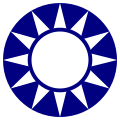The topic of this article may not meet Wikipedia's general notability guideline. (April 2025) |
| Part of a series on |
| Conservatism in Taiwan (Republic of China) |
|---|
 |
The Party Reform Program (Chinese: 中國國民黨改造方案; Wade–Giles: Chung1kuo2 Kuo2min2tang3 kai3tsao4 fang1an4; lit. 'Kuomintang Reform Program') was a party modernization campaign led by Chiang Kai-shek from 1950 to 1952, aimed at addressing the corruption, power-brokering, and factional struggles that had plagued the Kuomintang, which were seen as significant factors in the party's defeat in the Chinese Civil War. The program, based on Leninism, sought to reaffirm the KMT's adherence to democratic centralism, ideological purity, and the principle of party leadership over the state,[1][2][3][4][5] while isolating the influence of the CC Clique. This reform laid the groundwork for the dominance of Chen Cheng's Tsotanhui Clique and eventually facilitated Chiang Ching-kuo's succession.[6]
The reform was overseen by the Central Reform Committee, which established one office, seven departments, and five committees. Central Reform Committee were often regarded as Taiwan's "Supreme Cabinet" during the reform.[7]
- ^ 任育德. 向下紮根:中國國民黨與臺灣地方政治的發展(1949-1960).
- ^ Lloyd E. Eastman, "Who lost China? Chiang Kai-shek testifies," The China Quartesly, No. 88 (December 1981), pp. 658-668.
- ^ Myers, Ramon H., and Hsiao-ting Lin. "Breaking with the Past: The Kuomintang Central Reform Committee on Taiwan, 1950–52." (2007).
- ^ 任育德 (2009年). "中国国民党的改造". 台湾大百科全书.
- ^ Dickson, Bruce J. "The lessons of defeat: the reorganization of the Kuomintang on Taiwan, 1950–52." The China Quarterly 133 (1993): 56-84.
- ^ Kuo, Tai-Chün (2015). 台灣經濟轉型的故事: 從計劃經濟到市場經濟 (in Traditional Chinese). 聯經出版事業股份有限公司. pp. 54–58. ISBN 9789570845655.
- ^ 茅家琦 (1988). 台湾30年 1949-1979 (in Traditional Chinese). 河南人民出版社. p. 15. ISBN 978-7-215-00066-7.
© MMXXIII Rich X Search. We shall prevail. All rights reserved. Rich X Search
